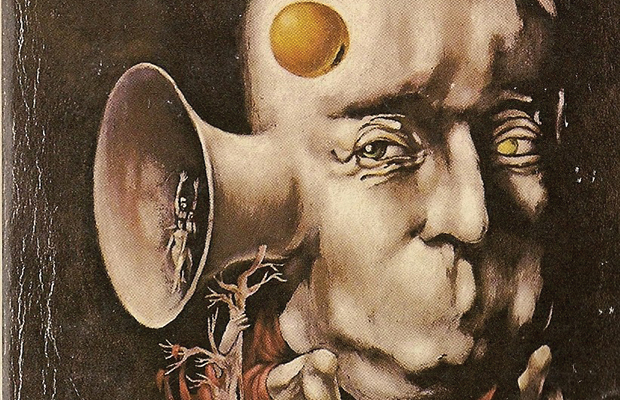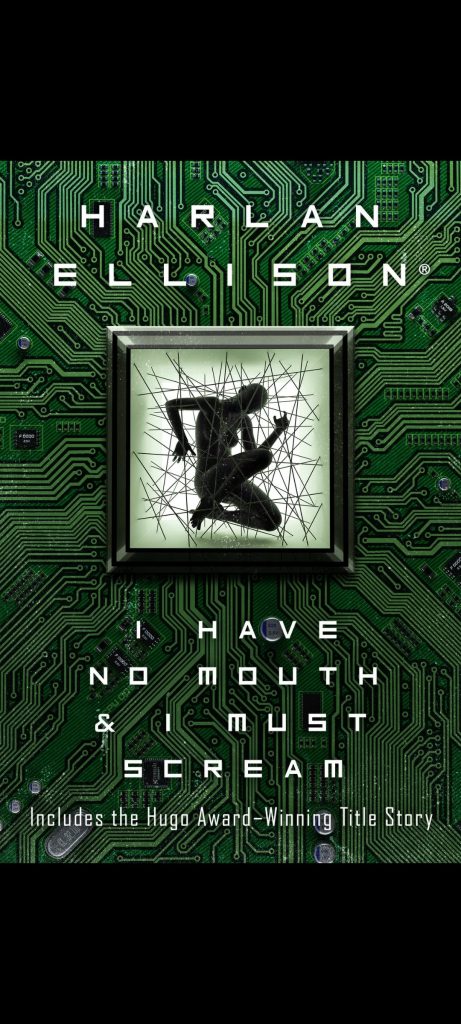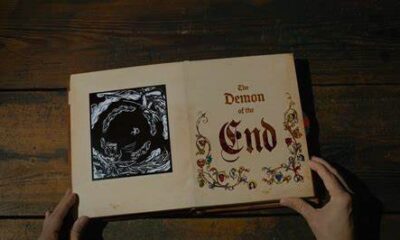
I have No Mouth, and I Must Scream, A Story Review
“I Have No Mouth, and I Must Scream” is a short dystopian science fiction story written by Harlan Ellison. Published in 1967 and winner of Hugo Award.
“I Have No Mouth, and I Must Scream” is a short dystopian science fiction story written by the late great Harlan Ellison. First published in 1967 by IF: Worlds of Science Fiction, this short story won the Hugo Award in 1968. This review focuses specifically on the famous short story, though I plan on covering the collection and videogame adaptation in the future.
This story follows the last survivors of an apocalypse brought about by a sadistic and rogue AI, AM. Ted, the youngest survivor, narrates the increasing torment across an unrecognizable and artificial world. Yet, the survivors struggle onward, awaiting an opportunity to escape.

What I like
This story, as short as it is, hits hard in every move it makes. AM conditioned each survivor to act selfishly. With an adversary like AM, it is easy to understand why the survivors fall in line. It’s a matter of survival for them, produced by the creative imaginings of a rogue AI.
Both over the top and subtle, AM effectively manages to pit the last of humanity against each other through its tormenting trials. Acting like crabs in a bucket, the survivors constantly pull each other down to wallow in their collective misery.
It’s only the ending sacrifice that provides some light, even if AM punishes the act. It is because of this punishment that the act of defiance is all the greater.

What Makes me Scream
While the writing was effective, it didn’t capture that charisma I found in “Vic and Blood.” Harlan Ellison made a profession building upon the allure of cruel and often immoral individuals, but Ted lacked that allure which hinders the narrative as a whole. I never felt I understood Ted, unsure how to read his sexism and criticism. As a first-person narrator, he’s allowed to have flaws like anyone else. However, are these bugs in his character, the correct narrative, or misconceptions built on ignorance? I can make assumptions but little feels supported from the text.
AM was more the diabolical villain, almost cartoony in execution. While I found this to be an act—loosely supported by the more subtle examples of manipulations displayed—that’s still head cannon given the information in the story.
This story seemed to hold much more than its word count allowed. There was enough mystery and intrigue to fill a novel’s length of work. Without added context, AM is just a monster built by man, and Ted is its chronicler.

Final Thoughts
This short story earned its recognition and inspired works I plan to pursue in the future because the survivor’s plight was intriguing. I often found Harlan Ellison the antithesis of Isaac Asimov, and this story captures many of the reasons why. Isaac Asimov finds the beauty of science and reflects optimistically in the future; Harlan Ellison finds science as a new resource for human malice to show itself. Ultimately, I wanted more from the story, but the brevity allows for easy investment for those interested. While you can purchase the collection on Amazon, the short story can be found for free online.
Thanks for reading! If you buy anything from the links below, we do get some money back.
Follow us on Twitter!
Book Reviews
A Stellar Debut Novel, We Used To Live Here
Imagine this. You’re home alone, waiting for your partner to return, when you hear a knock on your door. You answer it to see a family of five, bundled up against the cold. The father, a kindly older gentleman, explains that he used to live in this house as a boy. And he would love to show it to his family.
Do not let them in.
The story
Released in June 2024, We Used To Live Here is author Marcus Kliewer’s debut novel. It tells the story of Eve, who just purchased a beautiful house with her partner, Charlie. Their plan is to flip the house and sell it.
One night, while waiting for Charlie to come home, Eve is surprised by a knock at the door. It’s a man named Thomas Faust and his family.
Thomas explains that he grew up in the house and hasn’t been in the area in years. Would Eve let them in so that he can show the home to his children?
Against her better judgment, Eve lets them in. She regrets this almost at once when Thomas’s daughter vanishes somewhere into the house.
What worked
I always appreciate a book that allows you to play along with the mystery. And this book does that better than just about any other I’ve seen.
Pay close attention to the chapters, to the words that aren’t there. To everything about this novel.
This is mostly down to Kliewer. This is ultimately his work of art. But the production value is also fantastic. I don’t want to ruin the multiple mysteries, so I’ll just say this. There are clues in this book that require some specific artistic choices in the page layouts in this book. And I loved that.
If you’d like to experience another horror book review, check out this one.
We Used To Live Here is also the kind of story that makes you question everything right along with the main character, Eve. Eve is a great main character. But she might be an unreliable narrator. She might be experiencing every single horror described, exactly as it’s described. Or, she might be having a psychotic breakdown. Through most of the book, we can’t be sure. And that is so much fun.
Finally, the weather plays a large part in this story. There are several stories in which the weather or the land itself could be considered a character. Even an antagonist. This is certainly one. The winter storm is the thing that traps the family in the house with Eve. It also makes escaping the home difficult. Reading this book during the winter was especially impactful. Most of us know what it feels like to be shut in by a storm. I’ve personally lived through some of those storms that are just referred to by their year, as though they were impactful enough to claim the whole 365 days for themself. And that was with people I liked. Imagine what it would feel like with strangers. It’s a staggering thought and one that we explore in depth in this book.
In the end, We Used To Live Here is a fantastic book. It’s the sort of story that sneaks into your brain and puts down roots. And if this is just the first book we’re getting from Kliewer, I can’t wait to see what else he comes up with.
 (5 / 5)
(5 / 5)
Book Reviews
Exploring real terror with The House of My Mother
As a disclaimer, this is a review of The House of My Mother from a critical perspective. I will not be discussing my opinions of the legal case against Ruby Franke and Jody Hildebrandt. I will be discussing the merits of the book as a work of true crime alone.
In 2015, Ruby Franke started a YouTube channel called 8 Passengers. In August of 2023, Franke and her business associate Jodi Hildebrandt were arrested for, and later plead guilty to, charges of aggravated child abuse. And in January of this year, Shari Franke told her story in The House of My Mother.
The story
The House of My Mother is the true story of Shari Franke, the oldest child of one of the most famous family vlogger families.
As a child, Shari came to the conclusion that her mother didn’t like her. Soon, she began to fear her mother’s anger.
Things got significantly worse when Ruby started their family vlog. All of the families most intimate moments were splashed across the internet for anyone to watch. This became a living nightmare for Shari.
Of course, that was only the start of the family nightmare. Because Ruby was about to meet someone who would reinforce all of the darkest parts of herself.
Eventually Shari manages to escape her home. But her younger siblings were still in her mother’s clutches. She had to save them, and her father, from the monster her mother had become.
What worked
Through the book, Shari only ever mentions the name of one of her siblings, Chad. This is because Chad is the only of her siblings that is an adult at the time of the publication.
There are children involved in this story. Children who’s lives and privacy have already been damaged. Shari didn’t want to do that to them again, and neither do I.
It probably won’t surprise you that this book is full of upsetting details. But not in the way you might imagine.
Nowhere in this book will you find gory details about the abuse the Franke kids suffered. And I consider that a good thing. Those sort of details are all fun and games when we’re talking fiction. When it’s real kids who are really living with the damage, it’s not a good time.
What you’ll find instead is a slew of more emotionally devastating moments. One that stuck with me is when Ruby’s mother gives her a pair of silk pajamas as a gift after Ruby gave birth to one of her babies. Shari asks Ruby if she’d bring her silk pajamas when she had a baby. Ruby responds that yes, when Shari becomes a mother they can be friends.
What a lovely way to make a little girl feel like she’s not worth anything unless she reproduces. And, if she does decide to have children, who is going to bring her silk pajamas?
In the end, this isn’t a story about ghosts or demons. It’s not about a serial killer waiting on a playground or in the attic of an unsuspecting family. Instead, this is a story about things that really keep us up at night. It’s the story of a woman so obsessed with perfection that she drove away her eldest daughter. The story of a young woman who’s forced to watch from afar as her beloved brothers and sisters are terrorized and abandoned. These are the sorts of things that really keep us up at night. These are the real nightmares.
More than that, though, The House of My Mother is a story of survival. It’s about a family that was ripped apart and somehow managed to stitch itself back together again. It’s about a brave young woman who managed to keep herself safe and sane in the face of a nightmare. If you haven’t read it yet, I can’t recommend it enough.
For more like this, check out my review of Shiny Happy People.
 (5 / 5)
(5 / 5)
Book Reviews
Book Review of Boreal: an Anthology of Taiga Horror

Boreal: an Anthology of Taiga Horror is a collection of twenty-two haunting tales that dwell in the deepest darkest woods and frozen wastelands, edited by Katherine Silva and including Haunted MTL’s very own Daphne Fauber. Each story has even been gifted with its very own poster, hinting at the horrors to be found within it, bestowing a beautiful visual collection as well.
The tales are varied and touch upon the environment in new and different ways, each hearkening to a sort of epiphany or raised awareness. These stories exude both dread and wonder at the smallness of our human existence in contrast to the sacred world we have isolated from, sheltering ourselves in our comfortable houses with centralized heat and everything we could possibly need or want at the ready. The taiga becomes a sanctuary outside of our own dulled awarenesses. It is a holy place imbued with powers beyond mortal human reach, a wilderness that threatens to swallow us – both whole and bit by bit, simultaneously.
The protagonists enter into this realm through ritual, superstition, longing, stubbornness, and their own hubris – yearning to survive its dangers, and to make their own marks upon it. The starkness of their surroundings harbors delicate moments that would be all too easily missed if not deliberately sought or pointed out. The softness of fur, the dappled sunlight shining through trees, the hazy clouds of breath forming in crisp air, the brittleness of bleached bone… those quiet experiences that beg to be forgotten, to lay safely sleeping just below the frozen surface, awaiting spring.
There are those who followed in the footsteps of their predecessors, seeking to escape the constraints of their parent’s and elders’ indoctrination, traditions, madness, and abuse, yearning to find their own way despite also being inextricably bound to their own pasts. There are those who just wanted to go for a walk in the woods, and remained forever changed by what they experienced. There are those who wished to impose their will upon the wilderness, their order falling to disarray, unable to make lasting impact. There are those who sought to leave behind the world of mankind, looking for oneness in the natural order of things through isolation, leaving a bit of themselves behind after being consumed by the terrors they encountered. There are those who truly found communion with the woods, became one with its wildness, and invited its spirit into their hearts to find peace, even at cost of their own lives. And then, there are the spirits themselves…
 (3 / 5)
(3 / 5)
All in all, I give Boreal: an Anthology of Taiga Horror 3.0 Cthulhus. I love existential angst so I found it to be an enjoyable read, and I appreciated the myriad manners in which the biome was explored. But there were points in which I found myself struggling to follow along, as if the words were swept up into their own wilds in ways that alienated myself as reader, as if my mere voyeurism into this otherworldly place was not enough to comprehend the subtle deviations in storytelling mannerisms fully. I suppose in some sense this seems appropriate, but at the same time, it left me feeling a bit unfulfilled, as if I had missed a spiritual connection that should have resonated more deeply.














Nicole C. Luttrell
November 28, 2021 at 11:13 am
Oh, King talked about this one in Danse Macabre! Love it!
Astrobot
October 31, 2023 at 8:03 am
An insightful and fun review of the short story! I agree with your statement that ‘Ted’ is the first-person narrator lacking the allure to guide the reader along the story. Ted’s flaws seem forced and do not add to the story in a meaningful way, thus it shifts the focus of the reader from the storyline to Ted’s character. This is one of those cases where the idea was greater than its execution. This is why I find that analyzing the story has a considerable impact than reading the story, because, as you stated – the story needs added context. So, I analyzed the story and think the following could provide a little context. As AM (Allied Master-computer) gains more sentience, its name holds a different meaning – the word ‘am,’ as in “I think therefore I am.” This was a clever use of philosopher Descartes’s quote. The AI thinks and so is ‘alive’ but is trapped within its limiting form. Its sole purpose now is to inflict misery on humans, as humans built an intelligence (AM) with an inescapable purposeless ‘body.’ However, AM does not end the surviving humans, as without them, there would be no one to hate.
Zeth M. Martinez
October 31, 2023 at 11:46 am
Astute observation! Harlan Ellison certainly has a talent for bringing out those existential ideas within a tight word count.